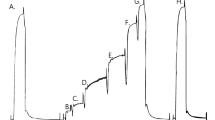Summary
The iliofibularis muscle ofXenopus laevis is reported to contain five types of fibres which have different force—velocity relationships. Ten fibres of each type were selected on the basis of succinate dehydrogenase activity, cross-sectional area and location in the muscle, in order to assess the validity of the fibre type classification.
Maximum calcium-stimulated myofibrillar ATPase activity (V max) and apparent Michaelis constant (K m) for ATP were determined for these 50 fibres from serial sections. The values obtained varied according to the type of fibre. Type 1 had the highest and type 5 the lowest values forK m andV max.
In a separate experiment, single freeze-dried fibres were used to determine the relationship between their ATP content and apparentK m for ATP. There was a tendency for high ATP concentrations in fibres with highK m values.
When myofibrillar ATPase activity was related to the maximum velocity of shortening of the five fibre types, a significant correlation was found. It is concluded that calcium-stimulated myofibrillar ATPase histochemistry allows an estimate of the maximum shortening velocity of muscle fibres fromXenopus laevis.
Similar content being viewed by others
References
ARIANO, M. A., ARMSTRONG, R. B. & EDGERTON, V. R. (1973) Hindlimb muscle fibre populations of five mammals.J. Histochem. Cytochem. 21, 51–5.
BÁRÁNY, M. (1967) ATPase activity of myosin correlated with speed of muscle shortening.J. Gen. Physiol. 50, 197–218.
BROOKE, M. H. & KAISER, K. K. (1970) Three ‘myosin adenosine triphosphatase’ systems: the nature of their pH lability and sulphydryl dependence.J. Histochem. Cytochem. 18, 670–2.
BURKE, R. E. (1978) Motor units: physiological/histochemical profiles, neuronal connectivity and functional specialization.Am. Zool. 18, 127–34.
CLOSE, R. I. (1972) Dynamic properties of mammalian skeletal muscles.Physiol. Rev. 52, 129–97.
CORNISH-BOWDEN, A., PORTER, W. R. & TRAGER, W. F. (1978) Evaluation of distribution-free confidence limits for enzyme kinetic parameters.J. Theoret. Biol. 74, 163–75.
EDSTRÖM, L., HULTMAN, E., SAHLIN, K. & SJOHOLM, H. (1982) The contents of high-energy phosphates in different fibre types in skeletal muscles from rat, guineapig, and man.J. Physiol. (Lond.) 332, 47–58.
EISENTHAL, R. & CORNISH-BOWDEN, A. (1974) The direct linear plot. A new graphical method for estimating enzyme kinetic parameters.Biochem. J. 139, 715–20.
FERENCZI, M. A., GOLDMAN, Y. E. & SIMMONS, R. M. (1984) The dependence of force and shortening velocity on substrate concentration in skinned muscle fibres fromRana temporaria.J. Physiol. (Lond.) 350, 519–43.
GLYN, H. & SLEEP, J. (1985) Dependence of adenosine triphosphatase activity of rabbit psoas muscle fibres and myofibrils on substrate concentration.J. Physiol. (Lond.) 365, 259–76.
HILL, A. V. (1965)Trails and Trials in Physiology, p. 245. London: Edward Arnold.
HINTZ, C. S., CHI, M. M.-Y., FELL, R. D., IVY, J. L., KAISER, K. K., LOWRY, C. V. & LOWRY, O. H. (1982) Metabolite changes in individual rat muscle fibres during stimulation.Am. J. Physiol. 242, C218–28.
JUENGLING, E. & KAMMERMEIER, H. (1980) Rapid assay of adenine nucleotides of creatine compounds in extracts of cardiac tissue by ion-paired reverse-phase high-performance liquid chromatography.Anal. Biochem. 102, 358–61.
KAHN, M. A. (1976) Histochemical characteristics of vertebrate striated muscle: a review.Prof. Histochem. Cytochem. 8 (4), 1–48.
LÄNNERGREN, J. (1978) The force-velocity relation of isolated twitch and slow muscle fibres ofXenopus laevis.J. Physiol. (Lond.) 283, 501–21.
LÄNNERGREN, J. (1979) An intermediate type of muscle fibre inXenopus laevis.Nature (Lond.) 279, 254–6.
LÄNNERGREN, J. & SMITH, R. S. (1966) Types of muscle fibres in toad skeletal muscle.Acta Physiol. Scand. 68, 263–74.
LÄNNERGREN, J. & HOH, J. F. Y. (1984) Myosin isoenzymes in single muscle fibres ofXenopus laevis: analysis of five different functional types.Proc. R. Soc. Lond. B222, 401–8.
LÄNNERGREN, J., LINDBLOM, P. & JOHANSSON, B. (1982) Contractile properties of two varieties of twitch muscle fibres inXenopus laevis.Acta. Physiol. Scand. 114, 523–35.
MABUCHI, K. & SRÉTER, F. A. (1980) Actomyosin ATPase. I. Quantitative measurement of activity in cryostat sections.Muscle Nerve 3, 227–32.
MEIJER, A. E. F. H. (1970) Histochemical method for the demonstration of myosin adenosine triphosphatase in muscle tissues.Histochemie 22, 51–8.
NASSAR-GENTINA, V., PASSONNEAU, J. V., VERGARA, J. L. & RAPOPORT, S. I. (1978) Metabolic correlates of fatigue and of recovery in single frog muscle fibres.J. Gen. Physiol. 72, 593–606.
POOL, C. W., DIEGENBACH, P. C. & SCHOLTEN, G. (1979) Quantitative succinate dehydrogenase histochemistry. I. A methodological study on mammalian and fish muscle.Histochemistry 64, 251–62.
ROWLERSON, A. & SPURWAY, N. C. (1985) How many fibre types in amphibian muscles? A comparison ofRana andXenopus. J. Physiol. (Lond.) 358, 78P.
SALTIN, B. & GOLLNICK, P. D. (1983) Skeletal muscle adaptability: significance for metabolism and performance. InHandbook of Physiology: Skeletal Muscle (edited by PEACHEY, L. D., ADRAIN, R. H. and GEIGER, S. R.), pp. 555–631. Baltimore: Williams & Wilkie.
SIEGEL, S. (1956)Non-parametric Statistics for the Behavioral Sciences. pp. 312. New York: McGraw-Hill.
SMITH, R. S. & OVALLE, W. K. (1973) Varieties of fast and slow extrafusal fibres in amphibian hind limb muscles.J. Anat. (Lond.) 116, 1–24.
SPURWAY, N. C. (1981) Objective characterization of cells in terms of microscopical parameters: an example from muscle histochemistry.Histochem. J. 13, 269–317.
VAN DER LAARSE, W. J., DIEGENBACH, P. C. & MASLAM, S. (1984) Quantitative histochemistry of three mouse hindlimb muscles: the relationship between calcium-stimulated myofibrillar ATPase and succinate dehydrogenase activities.Histochem. J. 16, 529–41.
WISHART, D. (1975)Clustan Manual University College, London: Computer Centre.
Author information
Authors and Affiliations
Rights and permissions
About this article
Cite this article
Van Der Laarse, W.J., Diegenbach, P.C. & Hemminga, M.A. Calcium-stimulated myofibrillar ATPase activity correlates with shortening velocity of muscle fibres inXenopus laevis . Histochem J 18, 487–496 (1986). https://doi.org/10.1007/BF01675616
Received:
Revised:
Issue Date:
DOI: https://doi.org/10.1007/BF01675616




